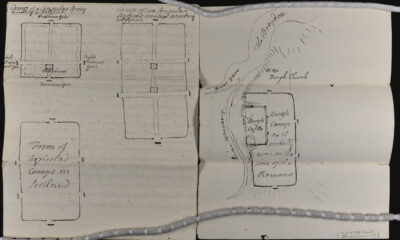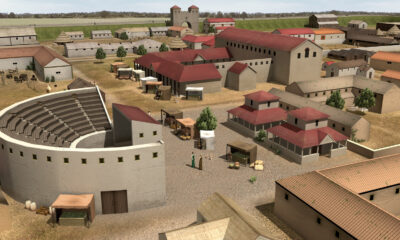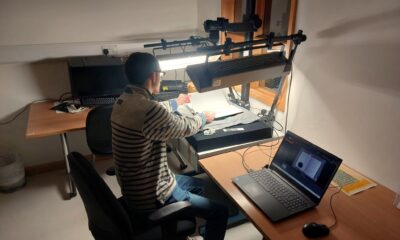 Some of the most unexpected connections in archaeology come from a good pair of eyes and a good memory – and sharing knowledge. This was proven by the Burgh Castle Almanac group recently when they visited Norwich Castle Museum art collections. The visit was organised by project managers, the Restoration Trust, as part of the ongoing activities that focus on historic landscapes and mental wellbeing at the Fort (1). The group were interested in viewing a number of images depicting Burgh Castle that have made their way into the collections at Norwich Castle Museum, including a 19th century plan of the site, and a water colour by the Reverend James Bulwer (1794 – 1879).
Some of the most unexpected connections in archaeology come from a good pair of eyes and a good memory – and sharing knowledge. This was proven by the Burgh Castle Almanac group recently when they visited Norwich Castle Museum art collections. The visit was organised by project managers, the Restoration Trust, as part of the ongoing activities that focus on historic landscapes and mental wellbeing at the Fort (1). The group were interested in viewing a number of images depicting Burgh Castle that have made their way into the collections at Norwich Castle Museum, including a 19th century plan of the site, and a water colour by the Reverend James Bulwer (1794 – 1879).
Not only does the Castle hold pictures of Burgh Castle, but it also has a watercolour painting of a extraordinary looking jar, or ‘ancient bottle’ found at the Fort on March 4th 1841 (left: Norwich Castle Collections: NWHCM : 1951.235.B224).
Having explored the art collection, the group were taking a walk through the museum and found themselves in the keep. One sharp-eyed person noticed there was a jar sitting in a display cabinet that looked like the one in the watercolour they’d just been looking at. On closer inspection, the label stated: ‘Jar, with a female face-mask on the neck. Made in Nene Valley, Cambridgeshire’(below left: Norwich Castle Collections: NWHCM:1932.158).
During the Roman period, there were a range of potteries making fine, ‘colour-coated’ ceramics, over the border in Cambridgeshire – these are known as Nene Valley Colour Coated wares. The label on the pot in the castle is not wrong – it tells us where this pot was manufactured – but there is no mention of Burgh Castle.
 Following the trip to the Castle Museum, we contacted the archaeology curator and asked if he knew whether the jar on display in the gallery was the same as the one illustrated in the art collection. What became clear was that the jar was accessioned in 1932 but the painting did not come into the museum’s collections until 1951. As a result, the connection had never been made – and the museum was not aware that the objects were linked. Having looked at the two records, the curator agreed it was very likely the jar did come from Burgh Castle.
Following the trip to the Castle Museum, we contacted the archaeology curator and asked if he knew whether the jar on display in the gallery was the same as the one illustrated in the art collection. What became clear was that the jar was accessioned in 1932 but the painting did not come into the museum’s collections until 1951. As a result, the connection had never been made – and the museum was not aware that the objects were linked. Having looked at the two records, the curator agreed it was very likely the jar did come from Burgh Castle.
Through knowledge-sharing, good eyesight and a good memory, a new connection has been made between these two objects, which enriches them both. A great example of citizen archaeology! All that needs to happen now is that the records at the museum are updated, and these objects will be linked for future researchers.
NH December 2018
(1) Burgh Castle Almanac is run by the Restoration Trust, in partnership with Norfolk Archaeological Trust and Stonham, supported by Access CT and Norfolk Museums Service. It is part of Water, Mills and Marshes, a Heritage Lottery Funded project led by the Broads Authority that aims to help people make the most of unique heritage sites and landscapes in the Norfolk and Suffolk Broads
For more information on Burgh Castle Almanac project go to http://burghcastlealmanac.org
For more information on the Water Mills and Marshes project of to www.watermillsandmarshes.org.uk





